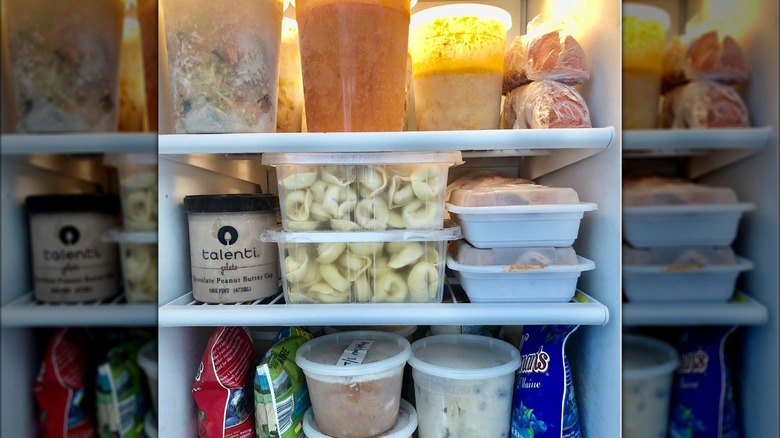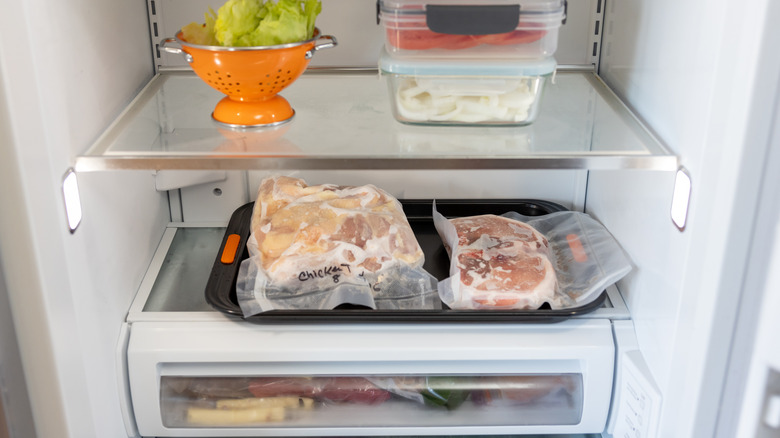Ina Garten's Expert Advice For Freezing Food In Containers
If your freezer is a black hole where food seems to always disappear in unmarked aluminum foil wrappers, you're not alone. Still, an adequately stocked and organized freezer can be a timesaver for home cooks, especially on busy nights when you don't have much time to prepare a meal. Take it from Ina Garten who learned this the hard way. The chef is now sharing her expert advice on Instagram, offering solid tips for freezing food in containers, in order to make meal prep much easier.
Garten noted that, before the pandemic, she only kept the essentials in her freezer — chicken stock, vanilla ice cream, and vodka (likely her favorite, Grey Goose). And while that may sound like the perfect "Girl Dinner," Garten realized she wasn't fully utilizing the valuable space.
Now, the Barefoot Contessa repurposes plastic takeout containers in order to easily keep sauces and soups on hand. As Garten suggests, just make sure the food you want to stock up on comes to room temperature before storing in the freezer, since placing hot food inside can raise the freezer's temperature, creating a dangerous environment for food-borne illnesses. As well, she says, leave ample space at the top of containers with liquids since they will expand as they freeze. Garten also offers additional tips on storing and defrosting when you're ready to use the food again.
Foods you can freeze and the best ways to store them
Take one look at Ina Garten's freezer picture on Instagram and you'll see she has a variety of foods inside, from soups to pasta to frozen fruit. Soups, stews, and sauces are among the most helpful items to stock in the freezer, since they defrost quickly and require little to no additional cooking (other than heating up) to complete a meal.
Properly wrapped raw meat freezes well, too, so stock up when you see a good sale. Beef, veal, pork, and lamb (steaks, chops, or roasts) can be frozen for up to a year, while ground meat should be cooked within four months. It's okay to keep the meat in its original packaging as long as it's double-wrapped with foil or placed in a freezer-safe baggie to prevent air from reaching the meat's surface.
No matter what you freeze, however, it's ideal to label the container with masking tape or removable freezer labels, as Garten points out. Although you think you will recognize your famous bolognese sauce, food looks similar when frozen. To avoid a guessing game, label food containers, including the date you first put it inside so you know how long it's good (frozen food has expiration dates, too).
Also, food should be frozen within two hours to maintain freshness. To expedite this process, Garten says, freeze food in smaller containers and spread them out in the freezer to allow the cold air to circulate. Once frozen, containers can be stacked to save space.
Garten's tips to properly defrost food
Ina Garten also shares best methods to safely defrost food, which she recommends doing in the refrigerator overnight, "rather than the counter." As she says, "It's safer!"
Although a room temp counter is faster, leaving frozen food out risks developing a food-borne illness. The food's exterior thaws quicker than the center, putting it in the "danger zone" where bacteria thrive. To avoid this situation, freeze food in smaller quantities so they thaw faster, properly.
For the same reason, refrain from using the microwave to thaw, since food defrosts unevenly in the appliance. Instead, place food in a bowl of cold water to quickly thaw it, changing the water every 30 minutes. However, containers of soup, stews, and sauces can be thawed safely in the microwave or stovetop without ruining their textures. Just stir the food periodically to break up frozen pieces and speed up the process.
Another tip — store individual servings of steaks, burgers, and slices of bread between parchment or freezer paper to remove only what you need rather than defrost the entire package. Frozen slices of bread can be toasted directly from the freezer, then smeared with butter since they will be drier. To keep their integrity, uncooked baked goods like raw cookie dough and pie shells should be baked directly from the freezer.
Once you have all these tips down, stock up! Keeping your freezer too empty also affects food quality.



